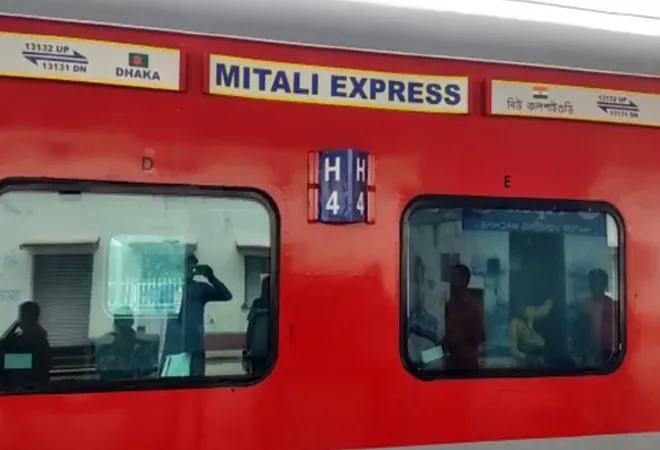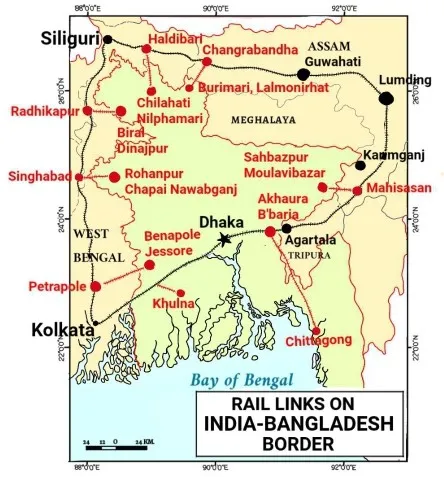
After a break of nine days for Eid celebrations, the
Mitali Express has once again resumed operations on 14 July. This train, running bi-weekly from New Jalpaiguri in northern West Bengal (henceforth referred to as North Bengal) to the capital city of Dhaka, Bangladesh, began its maiden journey last month. Due to the pandemic, it was delayed by 14 months following its virtual inauguration in
March 2021. This initiative is one of the many which have been undertaken in recent months by the Government of India (GOI) and Bangladesh to build better connectivity between the two countries, utilising India’s eastern state of West Bengal and the Northeastern territories, which form Bangladesh’s hinterland, beyond its national border.
The recently inaugurated Padma rail-road bridge in Bangladesh also holds the potential to improve physical linkages between the two countries.
Amongst the ongoing efforts to boost connectivity are Bangladesh’s offer to extend the
Chittagong Port to benefit India’s landlocked states of Assam and Tripura, the promise of operationalising the much-awaited
Akhaura–Agartala rail link by the end of 2022, and adding
new ports of call and protocol routes to the shared inland waterway network for better trade. Furthermore, Bangladesh has proposed connecting the land ports of
Bhadrapur-Bairagi Galgalia, Biratnagar-Jogmani and Birganj-Raxaul with Banglabandha-Fulbari and Birol-Radhikapur via road. The recently inaugurated
Padma rail-road bridge in Bangladesh also holds the potential to improve physical linkages between the two countries. In this multitude of initiatives, how the Mitali Express further advances connectivity between these countries and whether it benefits the wider sub-region, is worth contemplation.
Reviving linkages to reconnect lives
India’s strong connectivity with Bangladesh is deep-rooted in its civilisational history. Seven rail links operated between the two nations following the partition of 1947 till the outbreak of the Indo-Pakistani War of 1965. At present, five such rail links are operational between the neighbouring countries. The inauguration of the Mitali rail service has reopened the Haldibari-Chilahati route after. This express serves as the third passenger train after the Bandhan Express–running twice a week between Khulna and Kolkata and the Maitree Express–operating five times a week between Dhaka and Kolkata. Talks are on for starting a fourth passenger service, between Kolkata to Dhaka via Darshana, following a
recent meeting on 18 July between Indian High Commissioner Vikram Doraiswami and Bangladesh Railway Minister Mohd. Nurul Islam.
By way of improving connectivity, this train service has been designed to provide an affordable and reliable means of transportation between India and Bangladesh, which will in effect boost bilateral trade and the tourism industry.
The air-conditioned Mitali Express train service covers a distance of approximately 513 kilometres between Dhaka Cantonment and New Jalpaiguri, in nine hours. The train has
two technical stops at Haldibari and Chilahati, as it will be driven by an Indian driver and a Bangladeshi driver, on respective sides of the border. By way of improving connectivity, this train service has been designed to provide an affordable and reliable means of transportation between India and Bangladesh, which will in effect boost bilateral trade and the tourism industry. For example, by connecting Bangladesh with North Bengal, the Mitali Express facilitates travel for Bangladeshi tourists to favoured Indian destinations like Darjeeling, Dooars, and Sikkim. It, therefore, opens up more opportunities to establish robust people-to-people connections. As India’s North Bengal shares borders with Nepal, Bhutan, and Bangladesh, and its Northeast shares borders with Bangladesh, Myanmar, Bhutan, and even China, the train service also provides an avenue for expanding land connectivity with the wider subregion, as India aspires to in its ‘Neighbourhood First’ and ‘Act East’ Policy. Reopening of this route, also facilitates domestic transport within India, as it runs a shorter distance between Kolkata and Siliguri or New Jalpaiguri, thereby, reducing travel time by
four hours.
 Source: Map created by Jaya Thakur, Guest Faculty, Department of Geography, Jadavpur University, Kolkata.
Source: Map created by Jaya Thakur, Guest Faculty, Department of Geography, Jadavpur University, Kolkata.
For Bangladesh, the Mitali Express rail service is no less lucrative. By facilitating greater connectivity with India which translates to greater trading opportunities among other advantages, it provides political mileage to the Awami League Government which is led by Prime Minister Sheikh Hasina. This comes as she prepares for the upcoming parliamentary election in Bangladesh in 2023. Apart from scoring a diplomatic win through a mutually beneficial partnership, the rail service also benefits the people of Bangladesh with an affordable and comfortable mode of transportation, especially in the face of increasing
medical tourism. By connecting Bangladesh with North Bengal, the initiative also provides Bangladeshi citizens with a land route to
Nepal via India and the landlocked Himalayan country access to the sea for its commerce. It is thus a representation of what Prime Minister Hasina
stated in 2021, “political boundaries should not become physical trade barriers.” Indeed, the Mitali Express holds potential for enhancing connectivity in the sub-region, which has been a policy priority for both India and Bangladesh in recent years.
A step towards connecting the sub-region?
In the Summit meeting that was held between India and Bangladesh in Dhaka in March 2021 to celebrate 50 years of India–Bangladesh diplomatic ties, both the heads of state agreed to “
explore sub-regional connectivity initiatives that could not only lead to higher volumes of trade between eastern and north-eastern India, Bangladesh, Nepal, and Bhutan but also strengthen the Indo-Pacific construct.” With this broad agenda in mind, both countries discussed the early operationalisation of the Bangladesh, Bhutan, India, and Nepal (BBIN) Motor Vehicles Agreement by expediting the signing of the enabling MoU. This would allow Bangladesh, India, and Nepal to begin the transport of passengers and goods, with scope for Bhutan to join in future. In the strain of expanding land connectivity, Bangladesh had sought rail linkages with Bhutan via the route of Chilahati-Haldibari, on which the Mitali Express currently runs. Indeed, this train service adds to the opportunity for greater transit in the sub-region as it is speculated that it can serve as a link in the Trans-Asian Railway Network (TARN) project.
By connecting Bangladesh with North Bengal, the initiative also provides Bangladeshi citizens with a land route to Nepal via India and the landlocked Himalayan country access to the sea for its commerce.
Apart from the BBIN initiative, India and Bangladesh are also considering the platform of BIMSTEC to ramp up regional connectivity. The Bay of Bengal Multi-Sectoral Technical and Economic Cooperation (BIMSTEC) is the regional organisation devoted exclusively to the Bay of Bengal region, in which both India and Bangladesh are members. The BIMSTEC Master Plan on Transport Connectivity which was released by the Asian Development Bank in April 2022, devotes an entire section to rail transport since six out of its seven member countries are linked by land. In an interesting take, however, according to this plan, the “
railway sector is becoming less important for intra-BIMSTEC transport, and environmental factors favouring the use of rail are unlikely to appreciably change this trend.” This is because there is little shared interest regarding international rail services. Generating a regional momentum for developing rail infrastructure is therefore difficult. The only common need for rail links is to access important seaports, which is particularly important for the landlocked member states of BIMSTEC. Recently developing the shared Buddhist and temple circuit has also been identified as a common demand for improving rail connectivity.
It may be understood that from a sub-regional perspective, the utility of a labyrinth of railways is limited. Its scope increases when paired with other forms of transport. Therefore, to realise the true potential of a train service such as the Mitali Express, its reach needs to be expanded to major ports as well as Nepal and Bhutan—the other landlocked members of BIMSTEC— via multi-modal means. This, however, does not undermine its current significance which lies more at the bilateral level. Its present value is in connecting the two neighbouring countries and strengthening social and cultural ties between the people who share ethnolinguistic, historical, and cultural affinities. From a policy perspective, it highlights the growing bonhomie in India-Bangladesh relations.
The views expressed above belong to the author(s). ORF research and analyses now available on Telegram! Click here to access our curated content — blogs, longforms and interviews.



 After a break of nine days for Eid celebrations, the
After a break of nine days for Eid celebrations, the 
 PREV
PREV



